The Influence of Vibrations Induced by Blasting Works in an Open-Pit Mine and Seismic Events in an Underground Mine on Building Structures—A Case Study
Abstract
1. Introduction
2. Materials and Methods
2.1. Materials
2.2. Methods Used to Compare Vibrations Induced by Blasting Works and Underground Mine Tremors
- Comparison of the frequency structure of vibrations using third-octave filtering;
3. Results and Discussion
3.1. Results of Vibration Intensity Measurements
3.2. Comparison of Vibration Frequency Structure Using Third-Octave Filtering
3.3. Comparison of Vibration Impact Using SWD Scales
| zone I |
|
| line A |
|
| zone II |
|
| line B |
|
| zone III |
|
| line C |
|
| zone IV |
|
| line D |
|
| zone V |
|
3.4. Comparison of Vibration Impact Using the VPIB
- How distant the vibration parameters occurring in the building are from the lowest boundary line (line A)—VPIB ≤ 1;
- How many times this boundary has been exceeded—VPIB > 1.
3.5. Comparison of Impact Using MSIS-2017
- vx(t)—seismogram of the horizontal x component of vibration velocity;
- vy(t)—seismogram of the horizontal y component of vibration velocity.
- tk—a variable describing the dependence of intensity on time.
- t1—time after which (2) reaches 5% of the value of this integral, calculated for the entire recorded vibration record;
- t2—time after which (2) reaches 95% of the value of this integral, calculated for the entire recorded vibration record.
4. Conclusions
- Vibrations generated during blasting operations in an open-pit mine, whose intensity can be controlled by adjusting the parameters of the blasting operations (e.g., the mass of the explosive charges). This is the result of prior research aimed at minimizing the impact on structures surrounding the mine.
- Vibrations induced by natural mining tremors in an underground mine, which cannot be predicted in terms of occurrence time, location, and energy.
- Vibrations induced by blasting in open-pit mines and those caused by seismic events in underground mines are both sporadic events with short durations, resulting in brief interactions with the building structures.
- In the analyzed examples, the frequency characteristics of vibrations (vibration structure) from both sources are significantly similar. Vibrations induced by blasting predominantly range from 5.01 Hz to 7.98 Hz, while the dominant frequency range for vibrations induced by seismic events is broader, ranging from 3.98 Hz to 10.00 Hz.
- The assessment of the impact, conducted using the SWD-I scale of the PN-B-02170:2016-12 standard, categorizes vibrations induced by blasting in open-pit mines into zone I—negligible impact on building structures. However, vibrations induced by seismic events in underground mines fall into zone II of the SWD-I scale—non-damaging vibrations for the structures, but accelerated wear of the building can be expected.
- The previous conclusion is also supported by the comparative analysis using the VPIB indicator, which shows significantly higher values for seismic-induced vibrations.
- The assessment of the impact conducted using the MSIS-2017 categorizes vibrations induced by both blasting in open-pit mines and seismic events in underground mines as level 0—weakly perceptible, no damage.
- The parameter significantly differentiating vibrations is the Arias intensity of the seismic signal, as confirmed by the assessment using the MSIS-2017.
Author Contributions
Funding
Institutional Review Board Statement
Informed Consent Statement
Data Availability Statement
Conflicts of Interest
References
- Winzer, J.; Sołtys, A.; Pyra, J. Oddziaływanie na Otoczenie Robót z Użyciem Materiałów Wybuchowych, 1st ed.; The AGH University of Science and Technology Press: Cracow, Poland, 2016. (In Polish) [Google Scholar]
- Sołtys, A.; Pyra, J.; Winzer, J. The use of vibration monitoring to record the blasting works impact on buildings surrounding open-pit mines. In E3S Web of Conferences, Proceedings of the BIG 2018—4th Nationwide Scientific Conference on Engineering-Infrastructure-Mining, Kraków, Poland, 11–12 January 2018; EDP Sciences: Les Ulis, France, 2018. [Google Scholar] [CrossRef]
- Sołtys, A.; Pyra, J.; Chlebowski, D. Wstrząsy w kopalni podziemnej a roboty strzałowe w kopalni odkrywkowej—Porównanie oddziaływania na obiekty budowlane. Prz. Gór. 2016, 72, 1–12. (In Polish) [Google Scholar]
- Aswin, R.; Jobin, T.; Krishnajity; Sarfraz, M.; Kumar, A.C. Monitoring of ground vibration at a stone quarry. Int. J. Emerg. Technol. Innov. Res. 2021, 8, a101–a102. Available online: http://www.jetir.org/papers/JETIR2108014.pdf (accessed on 1 February 2024).
- Dubiński, J.; Stec, K.; Lurka, A. Oddziaływanie Wstrząsów Sejsmicznych na Powierzchnię w Zależności od ich Parametrów Fizycznych, 1st ed.; Wydawnictwa GIG: Katowice, Polska, 2005. (In Polish) [Google Scholar]
- Kopeć, A.; Bugajska, N.; Milczarek, W.; Głąbicki, D. Long-term monitoring of the impact operations on the ground surface at the regional scale based on the InSAR-SBAS technique, the Upper Silesian Coal Basin (Poland). Case study. Acta Geodyn. Geomater. 2022, 19, 93–110. [Google Scholar] [CrossRef]
- Avellan, K.; Belopotocanova, E.; Puurunen, M. Measuring, Monitoring and Prediction of Vibration Effects in Rock Masses in Near-Structure Blasting. Procedia Eng. 2017, 191, 504–511. [Google Scholar] [CrossRef]
- Yewuhalashet, F.; Hajime, I.; Hisatoshi, M.; Narihiro, O.; Tsuyoshi, A.; Youhei, K. Evaluation and Prediction of Blast-Induced Ground Vibrations: A Gaussian Process Regression (GPR) Approach. Mining 2023, 3, 659–682. [Google Scholar] [CrossRef]
- Zhang, G.; Wang, M.; Yang, R.; Si, K. Blasting vibration hazard classification and prediction research. Adv. Mech. Eng. 2023, 15, 16878132231181068. [Google Scholar] [CrossRef]
- Guo, J.; Zhao, P.; Li, P. Prediction and Optimization of Blasting-Induced Ground Vibration in Open-Pit Mines Using Intelligent Algorithms. Appl. Sci. 2023, 13, 7166. [Google Scholar] [CrossRef]
- Bańka, P.; Lurka, A.; Szuła, Ł. Ground Motion Prediction of High-Energy Mining Seismic Events: A Bootstrap Approach. Energies 2023, 16, 4075. [Google Scholar] [CrossRef]
- Nikkhah, A.; Vakylabad, A.B.; Hassanzadeh, A.; Niedoba, T.; Surowiak, A. An Evaluation on the Impact of Ore Fragmented by Blasting on Mining Performance. Minerals 2022, 12, 258. [Google Scholar] [CrossRef]
- Mbayo, P.N.; Tartibu, L.K. Développement D’une Approche Prédictive Pour L’analyse des Vibrations des Mines Souterraines en Utilisant D’un Algorithme Hybride (Réseau de Neurones Artificiels et Optimisation par Essaim de Particules ANN-PSO). Available online: https://www.academia.edu/83768937/D%C3%A9veloppement_dune_approche_pr%C3%A9dictive_pour_lanalyse_des_vibrations_des_mines_souterraines_en_utilisant_dun_algorithme_hybride_R%C3%A9seau_de_Neurones_Artificiels_et_Optimisation_par_Essaim_de_Particules_ANN_PSO (accessed on 3 March 2024).
- Simonenko, V.; Pavlychenko, A.; Cherniaiev, O. Assessment of the ecological efficiency of the open development of non-metallic deposits of useful minerals. Technol. Audit. Prod. Reserves 2018, 5, 21–27. [Google Scholar] [CrossRef]
- Agrawal, A.; Choundhary, B.S.; Murthy, V.M.S.R. A Comparative Study on Different Ground Vibration Evaluation Techniques in Surface Mines—Some inferences. In Proceedings of the National Seminar on Rock Blasting Technique Challenges and Opportunities, CSIR-CIMFR, Dhanbad, India, 23–24 November 2018. [Google Scholar]
- Yang, R.; Pratt, L.; Zhao, G. A Case Study on Trim Blast Fragmentation Optimization Using the MBF Model and the MSW Blast Vibration Model at an Open Pit Mine in Canada. Rock Mech. Rock Eng. 2023, 56, 3641–3658. [Google Scholar] [CrossRef]
- Sołtys, A.; Żołądek, T.; Rink, P. Creation of a database for the design of blasting works using the signature hole (SH) method. High Energy Mater. 2021, 13, 123–142. [Google Scholar]
- Sołtys, A. Metodyka Doboru Opóźnień Milisekundowych w Celu Minimalizacji Oddziaływania Drgań Wzbudzonych Robotami Strzałowymi na Obiekty Budowlane, 1st ed.; The AGH University of Science and Technology Press: Cracow, Poland, 2021. (In Polish) [Google Scholar]
- Yin, T.; Zhou, C.; Zheng, C.; Fu, J.; Guo, Z. The Vibration Characteristics of Ground of Rock Blasting in Silt-Rock Strata. Shock Vib. 2021, 2021, 3318965. [Google Scholar] [CrossRef]
- Standard PN-B-02170:2016-12; Polish Committee for Standardization. Evaluation of The Harmfulness of Buildings Vibrations Due to Ground Motion. PKN: Warsaw, Poland, 2016. (In Polish)
- Kawecki, J.; Stypuła, K. Błędy w prognozowaniu i diagnostyce wpływów dynamicznych na budynki. Czas. Tech. 2008, 105, 127–136. (In Polish) [Google Scholar]
- Singh, P.K.; Roy, M.P. Damage to surface structures due to underground coal mine blasting: Apprehension or real cause? Environ. Geol. 2008, 53, 1201–1211. [Google Scholar] [CrossRef]
- Witkowski, M.; Wodyński, A. Analysis of mining damage notifications in single-family buildings after the occurrence of intensive mining tremors. Geomat. Environ. Eng. 2015, 9, 101. [Google Scholar] [CrossRef]
- Darbinyan, T.P.; Uvarov, I.I.; Fedoseev, A.V.; Trofimov, A.V. Blasting-induced seismic impact on protected objects on ground surface at Zapolyarny Mine of Medvezhyi Ruchei LLC. Gorn. Z. 2023, 1, 102–106. [Google Scholar] [CrossRef]
- Pyra, J.; Kłaczyński, M. Vibroacoustic measurements and analysis of blasting works. J. Vibroeng. 2019, 21, 526–537. [Google Scholar] [CrossRef]
- Pyra, J.; Kłaczyński, M. Issues of Data Acquisition and Interpretation of Paraseismic Measuring Signals Triggered by the Detonation of Explosive Charges. Sensors 2021, 21, 1290. [Google Scholar] [CrossRef]
- Shirani Faradonbeh, R.; Jahed Armaghani, D.; Abd Majid, M.Z.; Md Tahir, M.; Ramesh Murlidhar, B.; Monjezi, M.; Wong, H.M. Prediction of ground vibration due to quarry blasting based on gene expression programming: A new model for peak particle velocity prediction. Int. J. Environ. Sci. Technol. 2016, 13, 1453–1464. [Google Scholar] [CrossRef]
- Gao, J.; Huang, C.; Huang, X.; Ren, J.J.; Wang, N. A Study of Blast Vibration Propagation Law under Negative Altitude Terrains. Math. Probl. Eng. 2022, 2022, 4289057. [Google Scholar] [CrossRef]
- Lishun, L.; Xiaocong, Y.; He, W.; Yucheng, Z. Study on the vibration effect of open-pit and underground combined mining by piecewise fitting Sadowski formula. In Rock Dynamics: Progress and Prospect, 1st ed.; CRC Press: London, UK, 2023; Volume 2. [Google Scholar] [CrossRef]
- Konicek, P.; Waclawik, P. Stress changes and seismicity monitoring of hard coal longwall mining in high rockburst risk areas. Tunn. Undergr. Space Technol. 2018, 81, 237–251. [Google Scholar] [CrossRef]
- Galvin, J.M. Ground Engineering—Principles and Practices for Underground Coal Mining, 1st ed.; Springer International Publishing: Cham, Switzerland, 2016. [Google Scholar] [CrossRef]
- Chen, D.; Martin Mai, P. Automatic identification model of micro-earthquakes and blasting events in Laohutai coal mine based on the measurement of source parameter difference. Measurement 2021, 184, 109883. [Google Scholar] [CrossRef]
- Zhang, W.; Ma, N.; Ren, J.; Li, C. Peak particle velocity of vibration events in underground coal mine and their caused stress increment. Measurement 2021, 169, 108520. [Google Scholar] [CrossRef]
- Pilecka, E.; Stec, K.; Chodacki, J.; Pilecki, Z.; Szermer-Zaucha, R.; Krawiec, K. The Impact of High-Energy Mining-Induced Tremor in a Fault Zone on Damage to Buildings. Energies 2021, 14, 4112. [Google Scholar] [CrossRef]
- Bryt Nitarska, I. Effects of strong mining tremors, and assessment of the buildings’ resistance to the dynamic impacts. In E3S Web of Conferences, Proceedings of the BIG 2018—4th Nationwide Scientific Conference on Engineering-Infrastructure-Mining, Kraków, Poland, 11–12 January 2018; EDP Sciences: Les Ulis, France, 2018. [Google Scholar] [CrossRef]
- Kutuev, V.; Menshikov, P.; Zharikov, S.N. Blasting impact on underground openings in Magnezitovaya Mine. IOP Conf. Ser. Earth Environ. Sci. 2022, 991, 012031. [Google Scholar] [CrossRef]
- Tatara, T.; Fedorczak-Cisak, M.; Kowalska-Koczwara, A.; Pachla, F. Computational and Approximate Analysis of the Impact of Mining Vibrations on People Staying in Buildings. In Proceedings of the 14th International Conference on Vibration Problems, ICOVP 2019, Crete, Greece, 1–4 September 2019; Sapountzakis, E.J., Banerjee, M., Biswas, P., Inan, E., Eds.; Lecture Notes in Mechanical Engineering; Springer: Singapore, 2019. [Google Scholar] [CrossRef]
- Yang, C.H.; Stemmler, C.; Pakzad, K.; Zimmermann, K.; Müterthies, A. Integrated Mining Impact Monitoring (EU-Project i2Mon) for Open-pit and Underground Mines. Int. Arch. Photogramm. Remote Sens. Spat. Inf. Sci. 2022, 43, 367–372. [Google Scholar] [CrossRef]
- Nedoma, J.; Stolarik, M.; Fajkus, M.; Pinka, M.; Hejduk, S. Use of Fiber-Optic Sensors for the Detection of the Rail Vehicles and Monitoring of the Rock Mass Dynamic Response Due to Railway Rolling Stock for the Civil Engineering Needs. Appl. Sci. 2019, 9, 134. [Google Scholar] [CrossRef]
- Dubiński, J.; Stec, K.; Mutke, G. Relationship between the focal mechanism of magnitude M L 3.3 seismic event induced by mining and distribution of peak ground velocity. In E3S Web of Conferences 24, AG 2017—3rd International Conference on Applied Geophysics, Gniew, Poland, 21–23 June 2017; EDP Sciences: Les Ulis, France, 2017. [Google Scholar] [CrossRef]
- Chodacki, J. New Ground Motion Prediction Equation for Peak Ground Velocity and Duration of Ground Motion for Mining Tremors in Upper Silesia. Acta Geophys. 2016, 64, 2449–2470. [Google Scholar] [CrossRef]
- Dubiński, J.; Mutke, G.; Chodacki, J. Distribution of peak ground vibration caused by mining induced seismic events in the upper silesian coal basin in Poland. Arch. Min. Sci. 2020, 65, 14. [Google Scholar] [CrossRef]
- Mutke, G.; Lurka, A.; Zembaty, Z. Prediction of rotational ground motion for mining-induced seismicity—Case study from Upper Silesian Coal Basin, Poland. Eng. Geol. 2020, 276, 105767. [Google Scholar] [CrossRef]
- Kuźniar, K.; Chudyba, Ł. Wykorzystanie sieci neuronowych do prognozowania przekazywania drgań wzbudzanych wstrząsami górniczymi z gruntu na budynek. Czas. Tech. 2010, 11, 109–117. (In Polish) [Google Scholar]
- Mutke, G. Oddziaływanie Górniczych Wstrząsów Sejsmicznych na Powierzchnię, 1st ed.; Wydawnictwa GIG: Katowice, Polska, 2019. (In Polish) [Google Scholar]
- Mutke, G.; Chodacki, J.; Muszyński, L.; Kremers, S.; Fritschen, R. Mining Seismic Instrumental Intensity Scale MSIIS-15—Verification in coal basins. In Proceedings of the Fifth Internayional Symposium Mineral Resources and Mine Development, Aachen, Germany, 27–28 May 2015; Volume 14, pp. 551–560. [Google Scholar]
- Mutke, G.; Marcak, H.; Mutke, F.; Barański, A. Metoda wyznaczania mapy roskładu intensywności sejsmicznej IGSI po wystąpieniu silnego wstrząsu pochodzenia górniczego. Prze. Gór. 2017, 73, 51–58. (In Polish) [Google Scholar]
- Available online: http://pczk.pl/informacje-o-wstrzasach-gorniczych.html (accessed on 15 January 2024).
- Available online: https://grss.gig.eu/mapa-wstrzasow/ (accessed on 15 January 2024).
- Sołtys, A.; Chlebowski, D. Methodology of designing blasting works in open pit mining in terms of their impact on construction objects. Acta Montan. Slovaca 2023, 28, 344–357. [Google Scholar] [CrossRef]
- Stypuła, K. O zmianach w normie PN-B-02170 dotyczącej oceny wpływu drgań przekazywanych na budynki przez podłoże. Prze. Bud. 2017, 10, 125–128. (In Polish) [Google Scholar]
- Barański, A.; Chodacki, J.; Dubiński, J.; Kowal, T.; Lurka, A.; Muszyński, L.; Mutke, G.; Stec, K. Zasady stosowania Górniczej Skali Instensywności Sejsmicznej GSIS-2017 do Prognozy i Oceny Skutków Oddziaływania Wstrząsów Indukowanych Eksploatacją na Obiekty Budowlane Oraz Klasyfikacji ich Odporności Dynamicznej; Zespół Wydawnictw i Usług Poligraficznych Głównego Instytutu Górnictwa: Katowice, Polska, 2018. (In Polish) [Google Scholar]
- Kuzniar, K.; Stec, K.; Tatara, T. Comparison of approximate assessments of the harmfulness of mining shocks using ground and building foundation vibrations. J. Meas. Eng. 2018, 6, 218–225. [Google Scholar] [CrossRef]
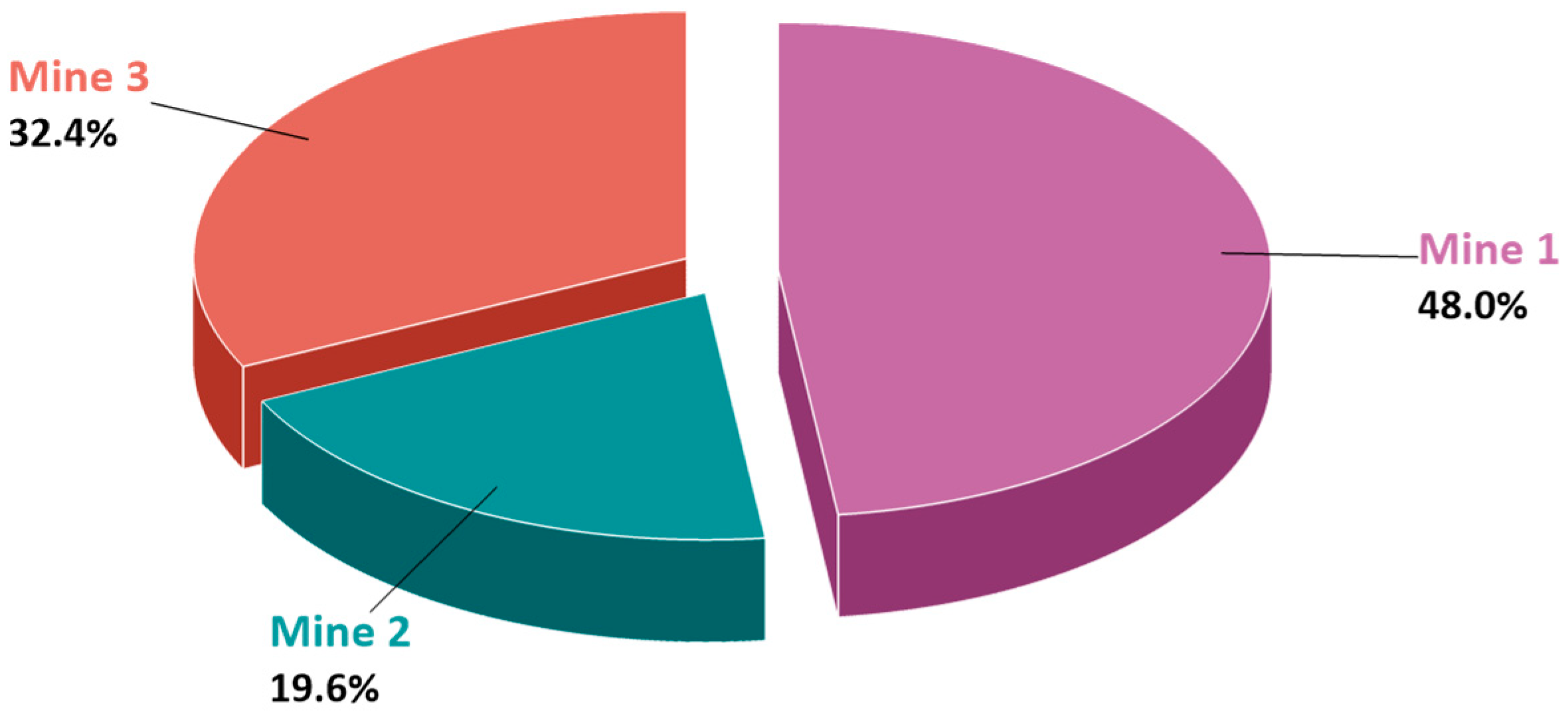
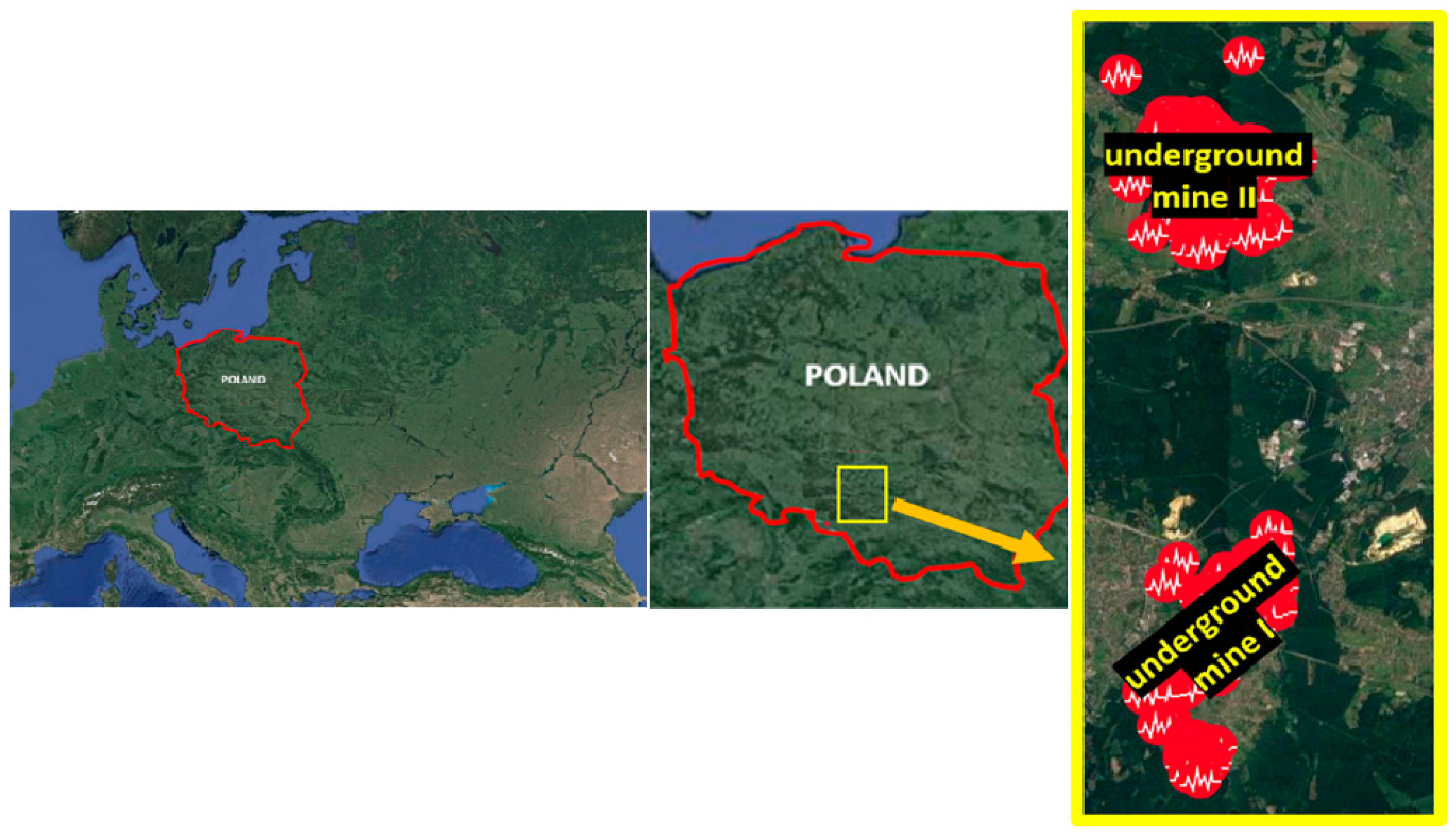
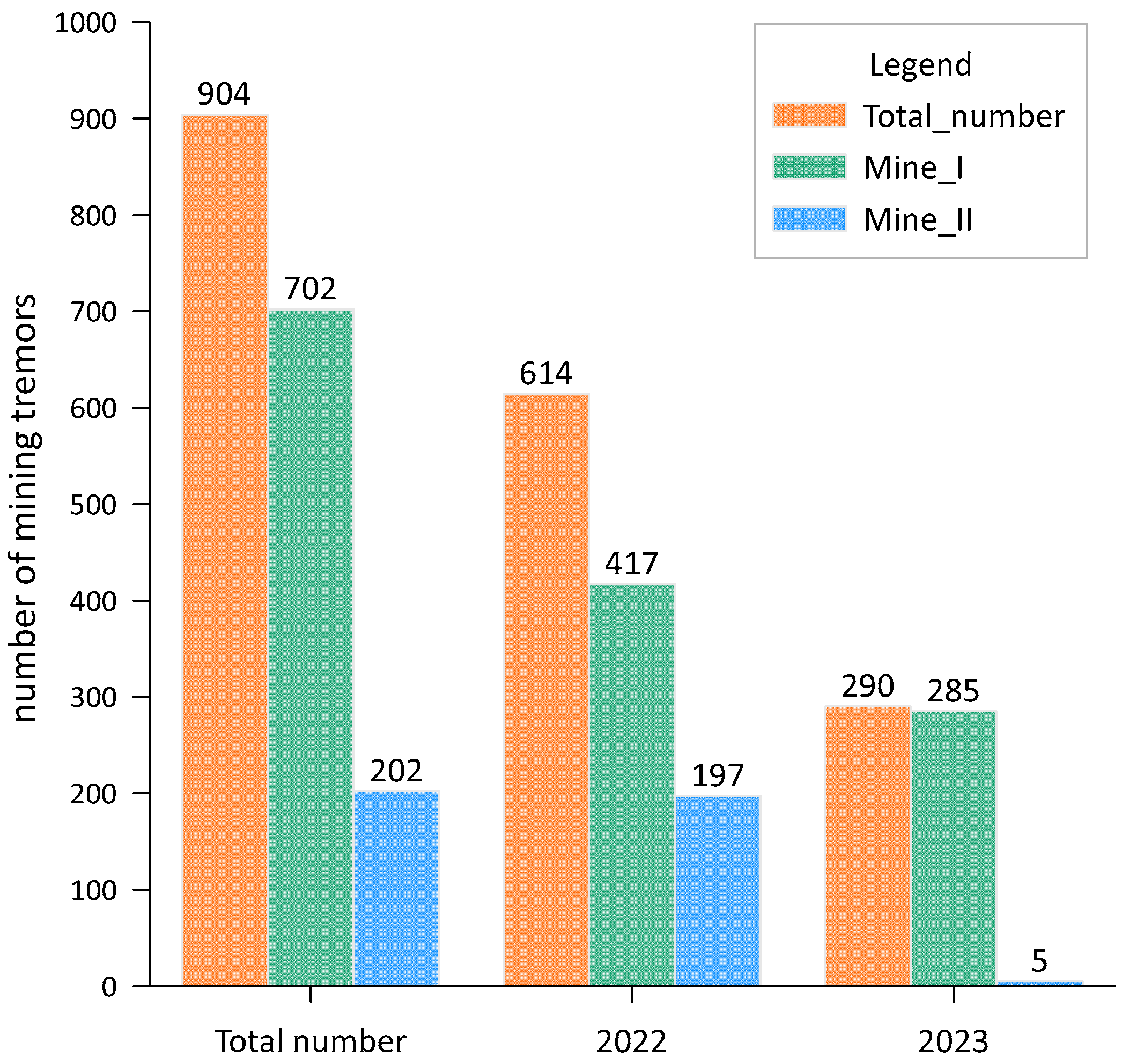
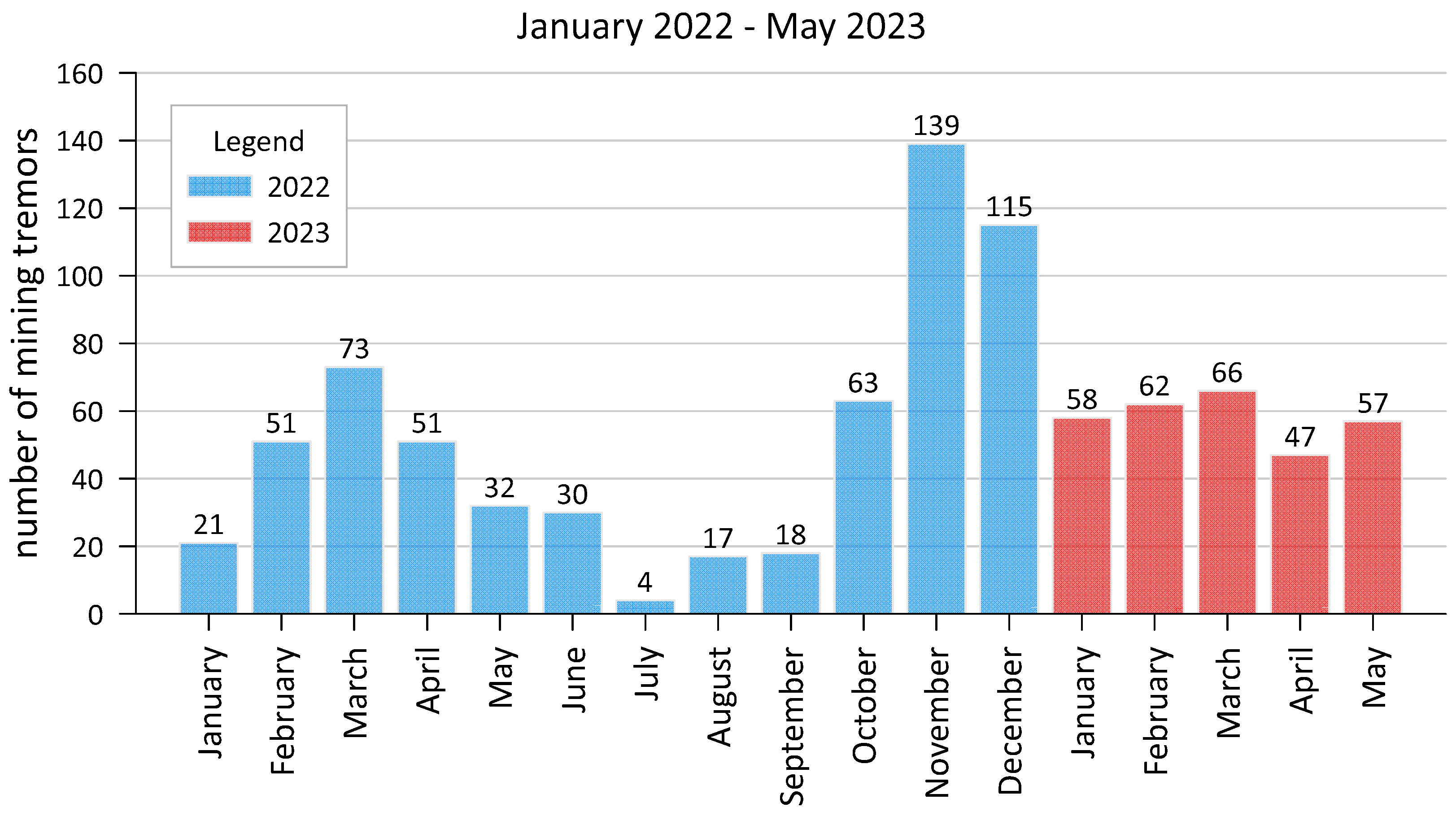
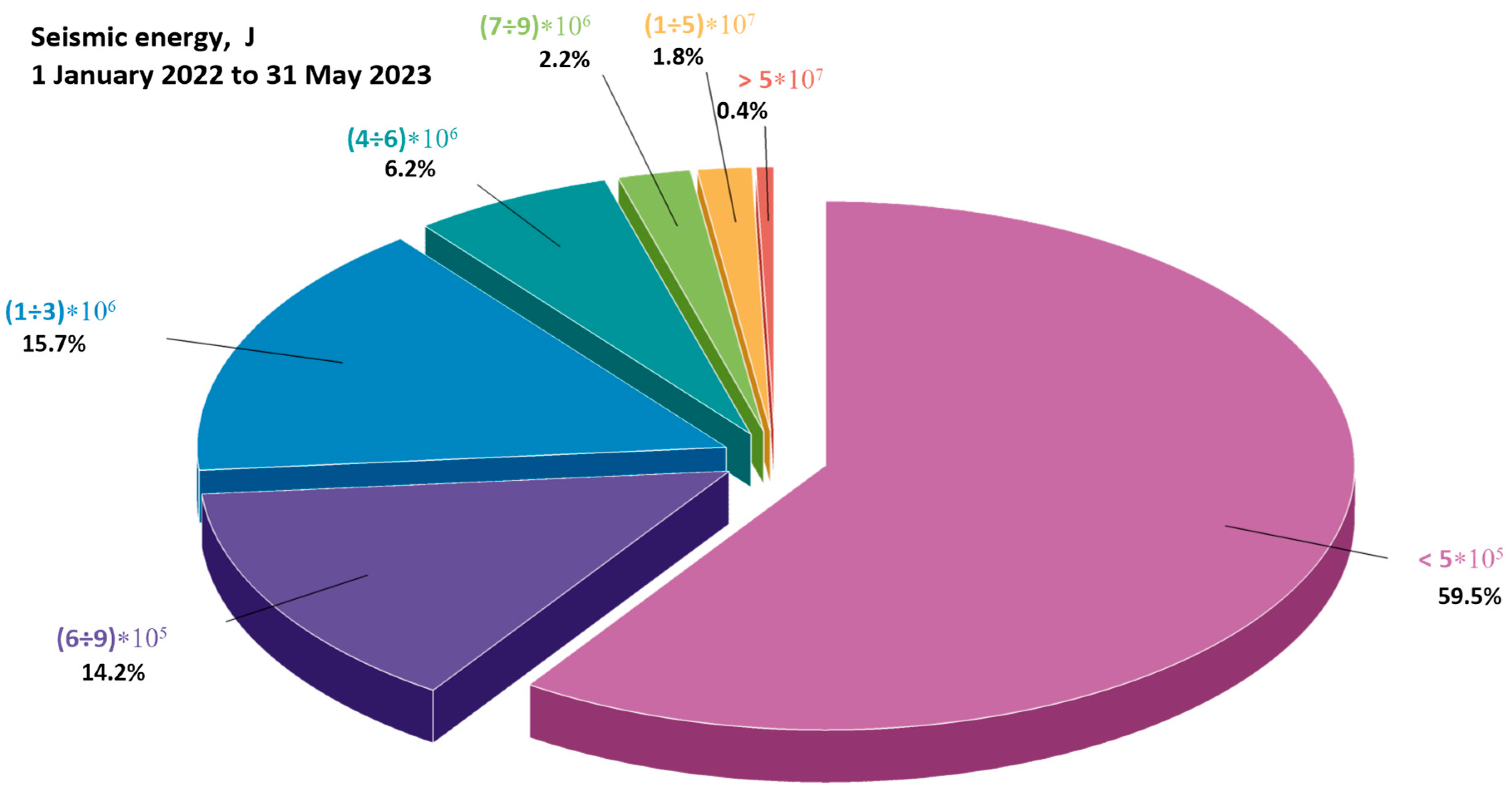
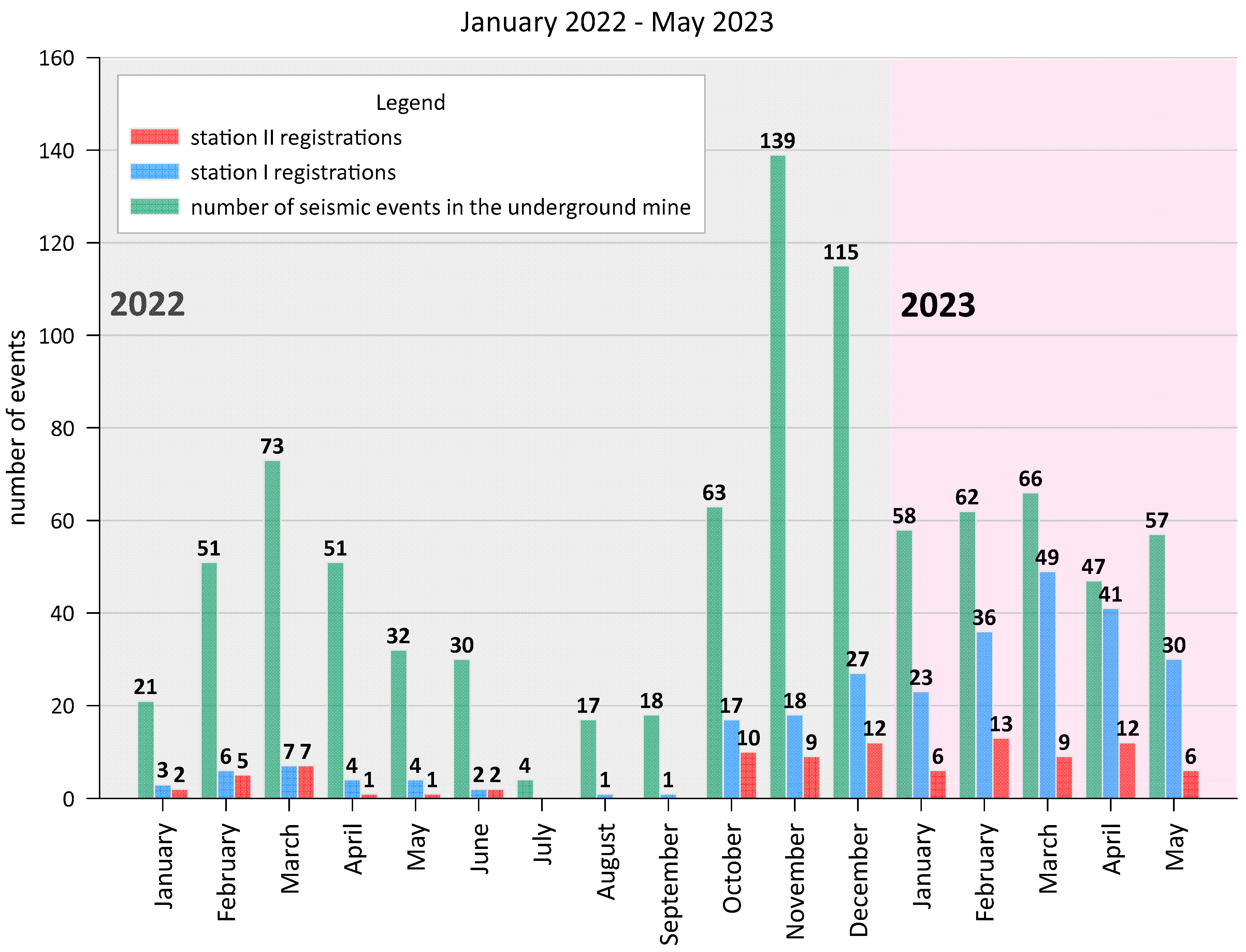
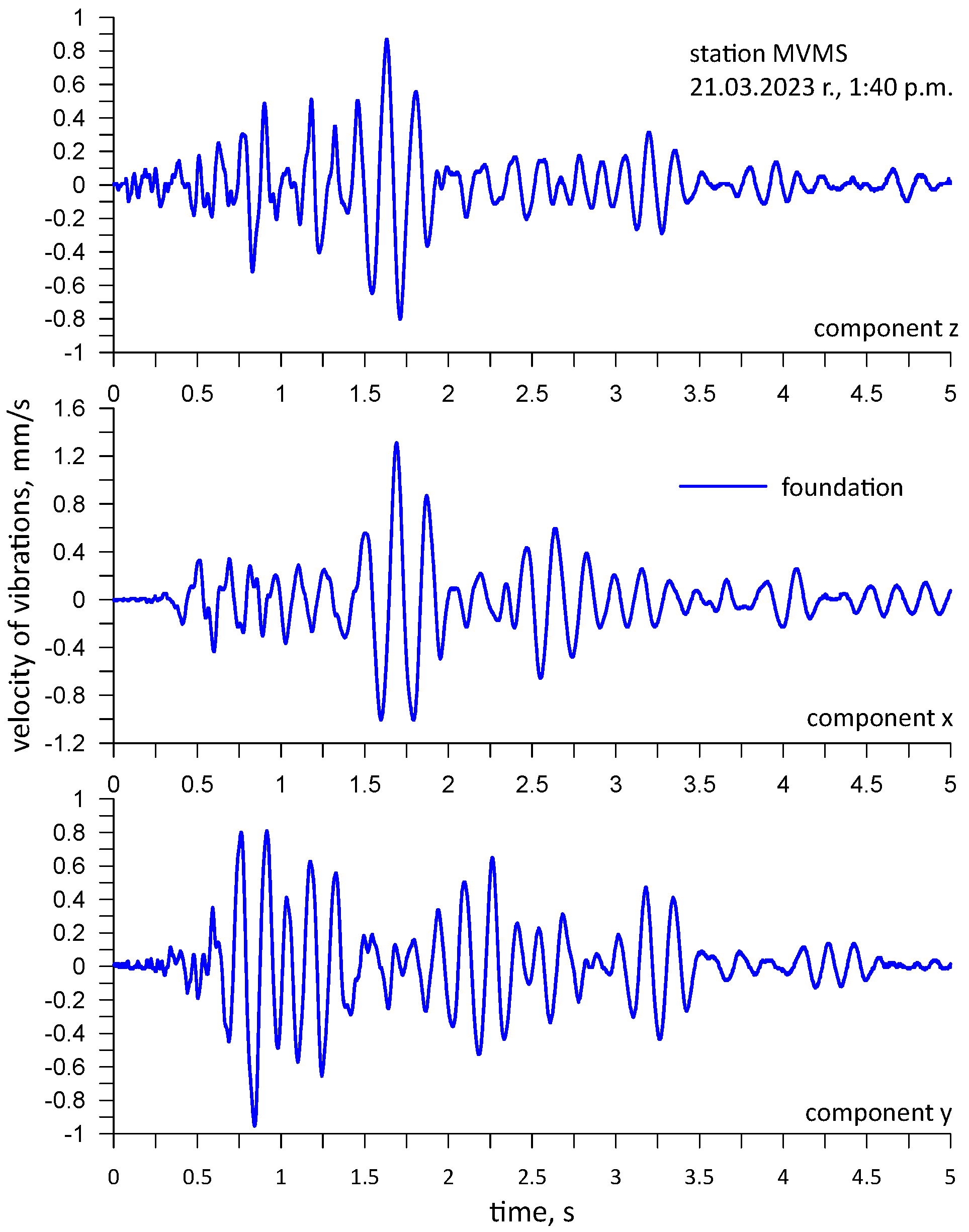

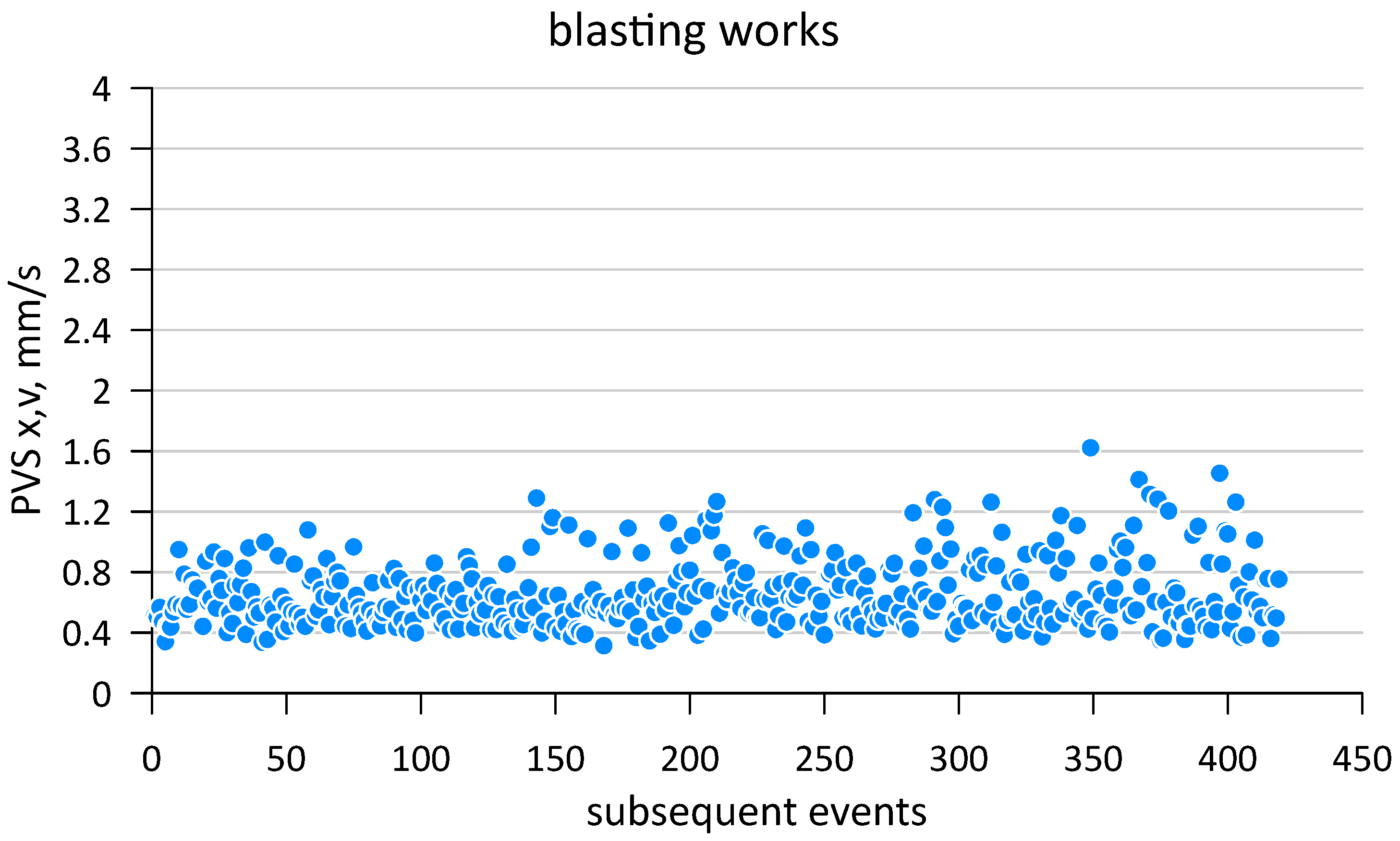
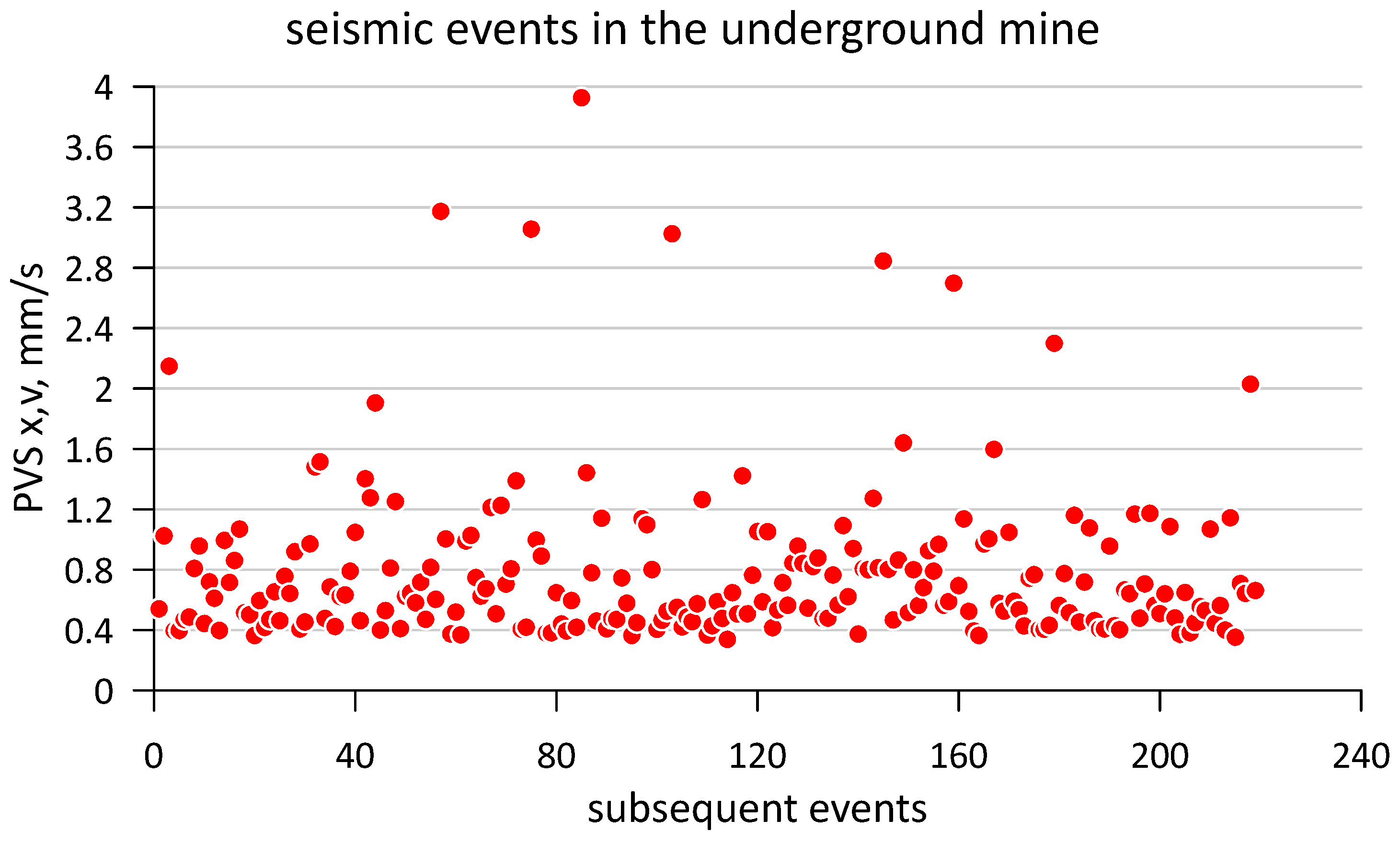
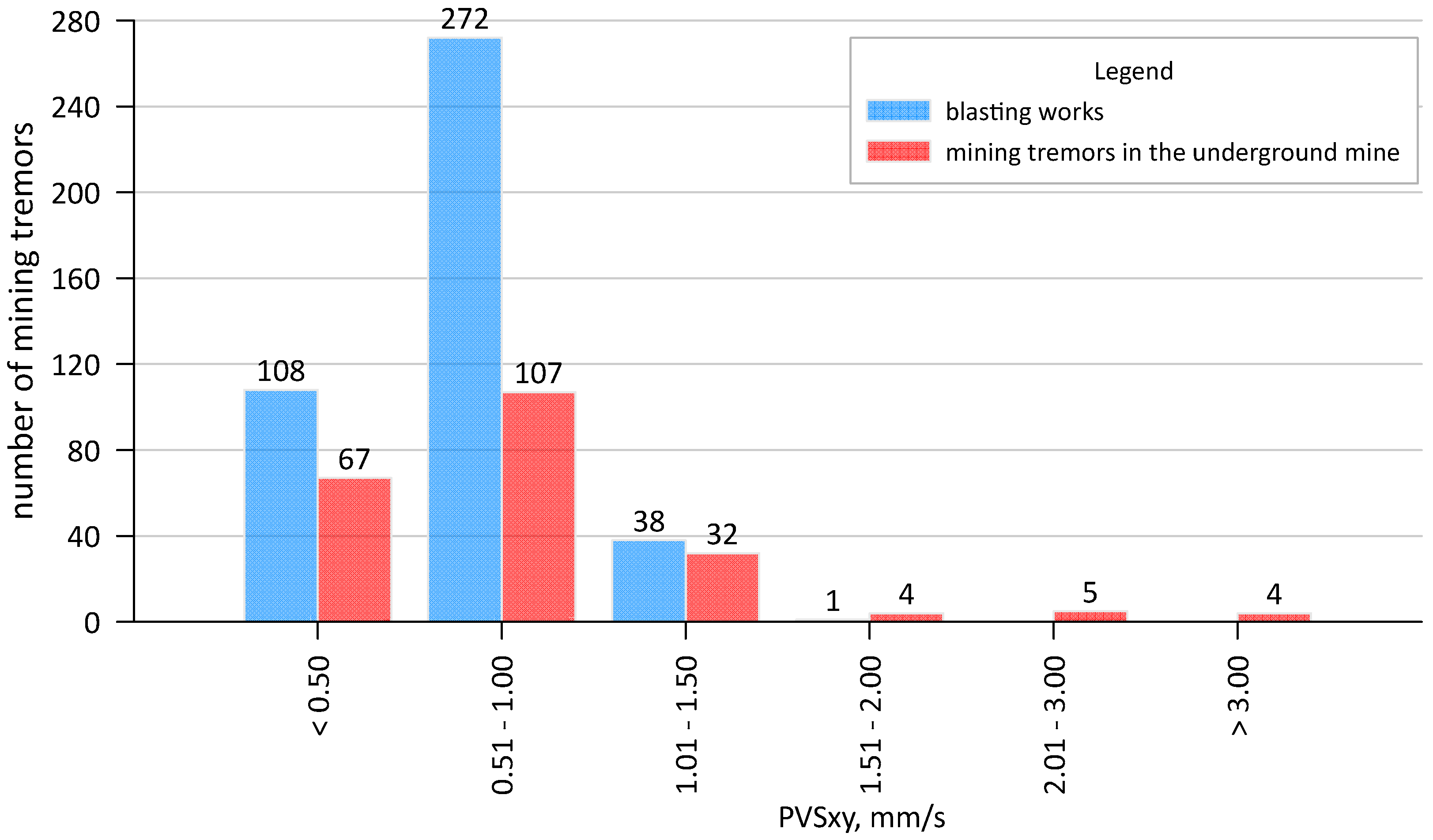
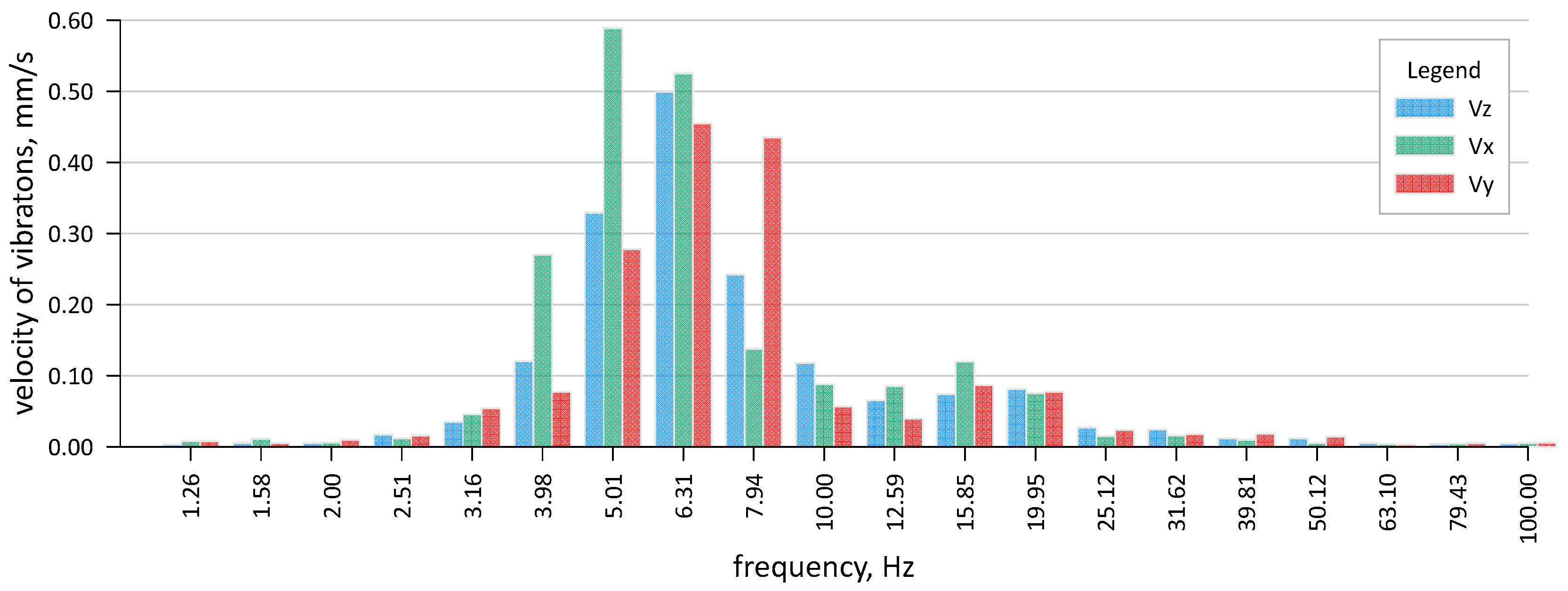
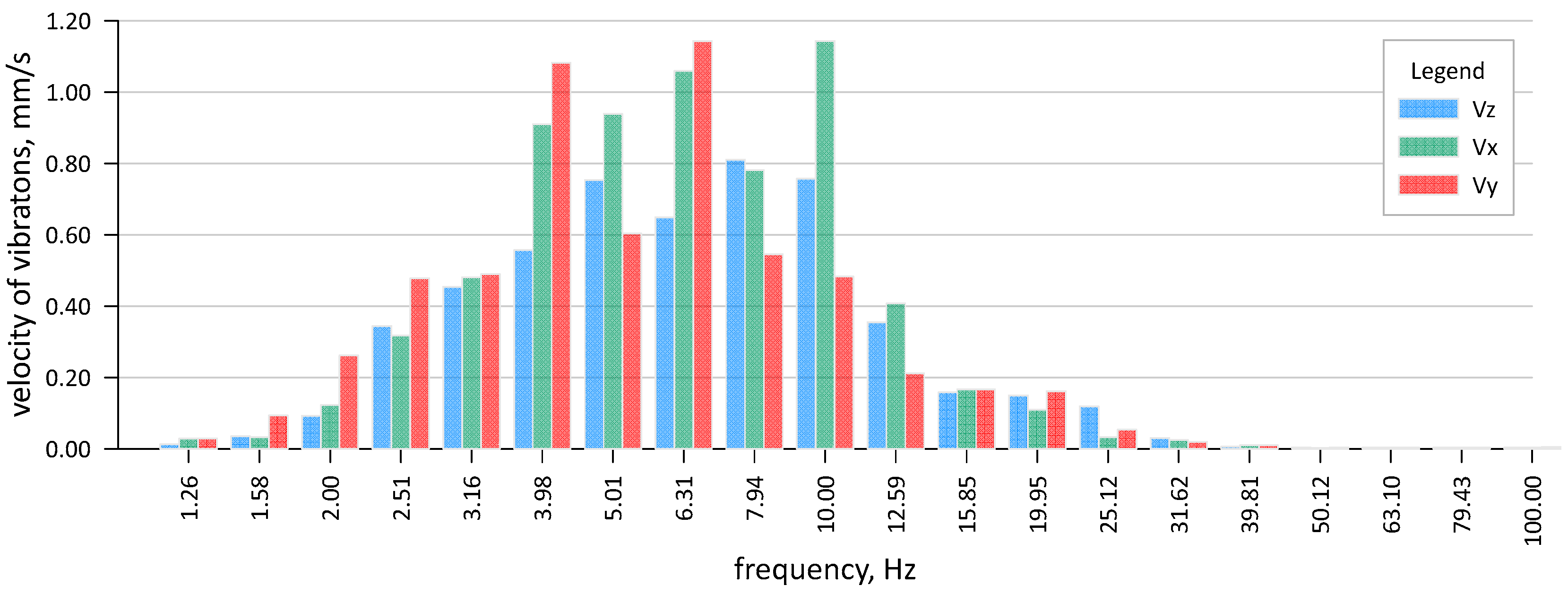
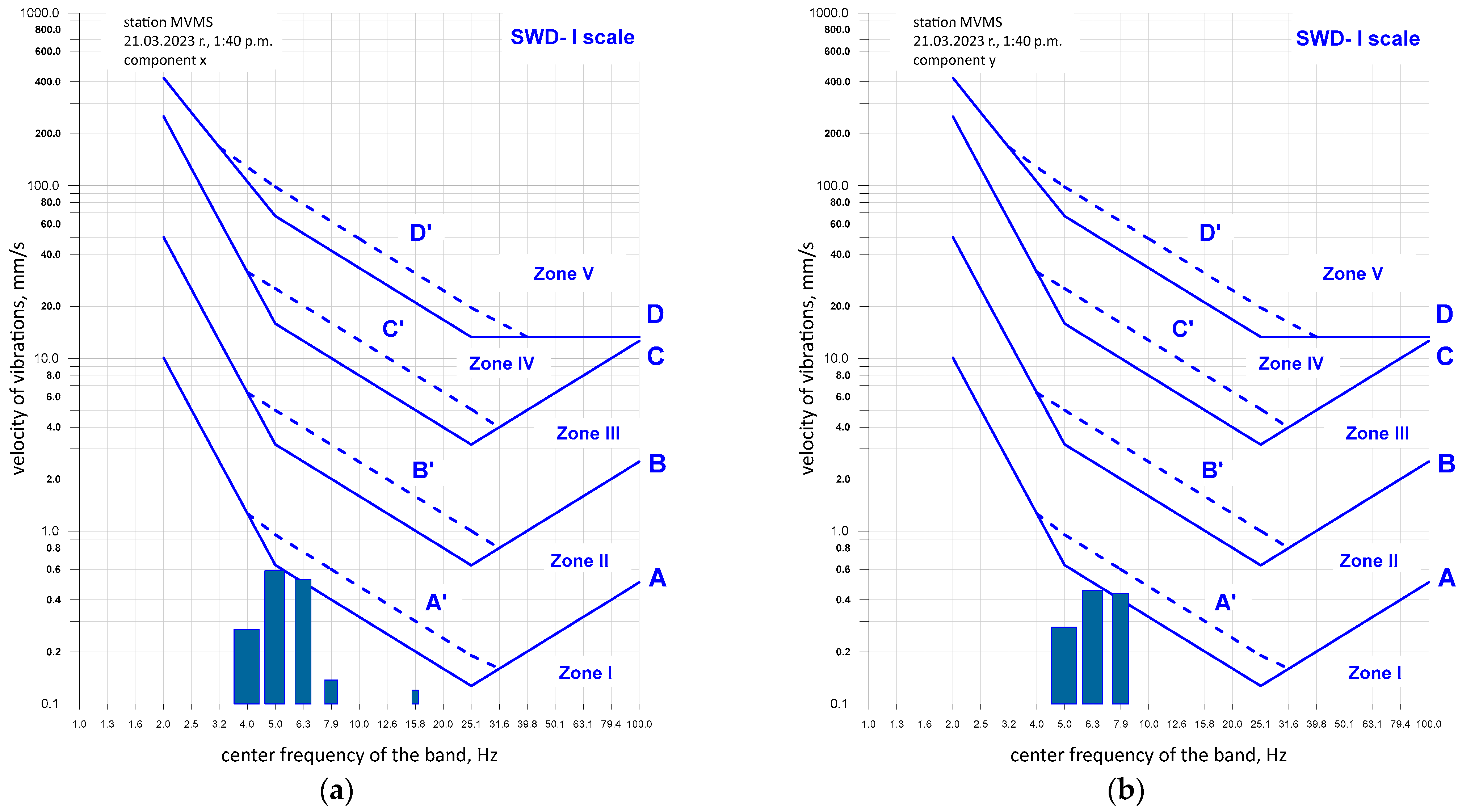
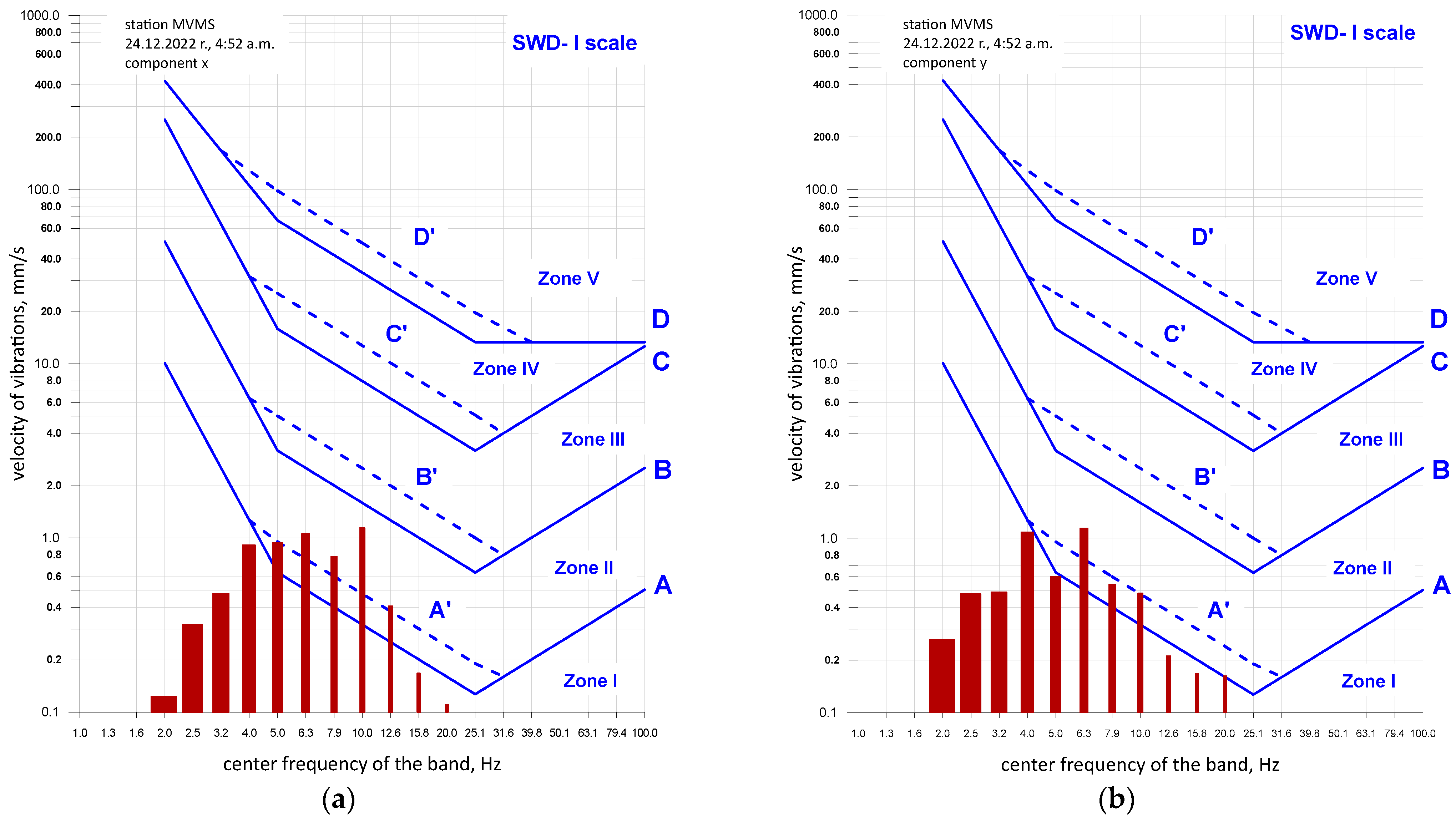
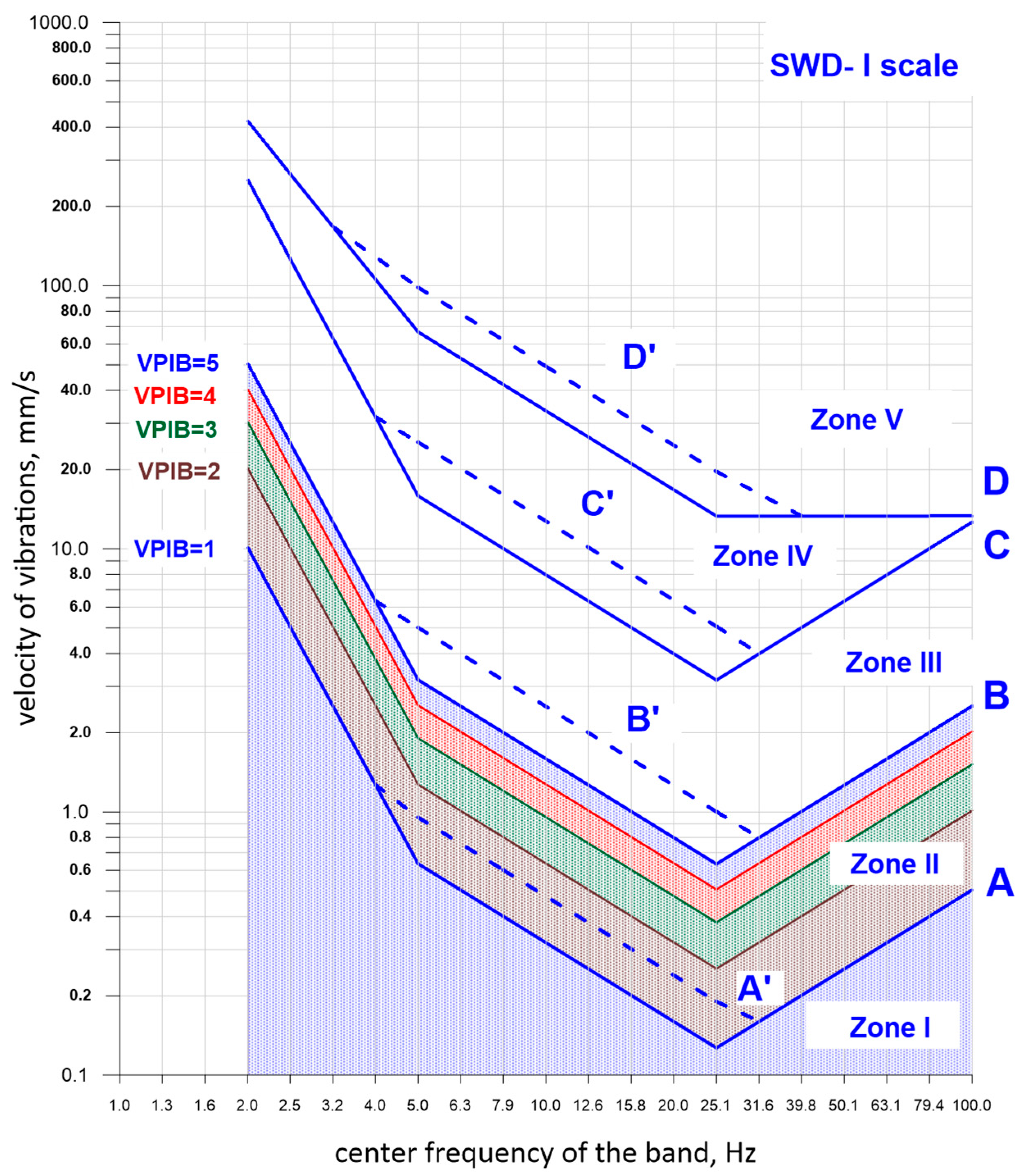

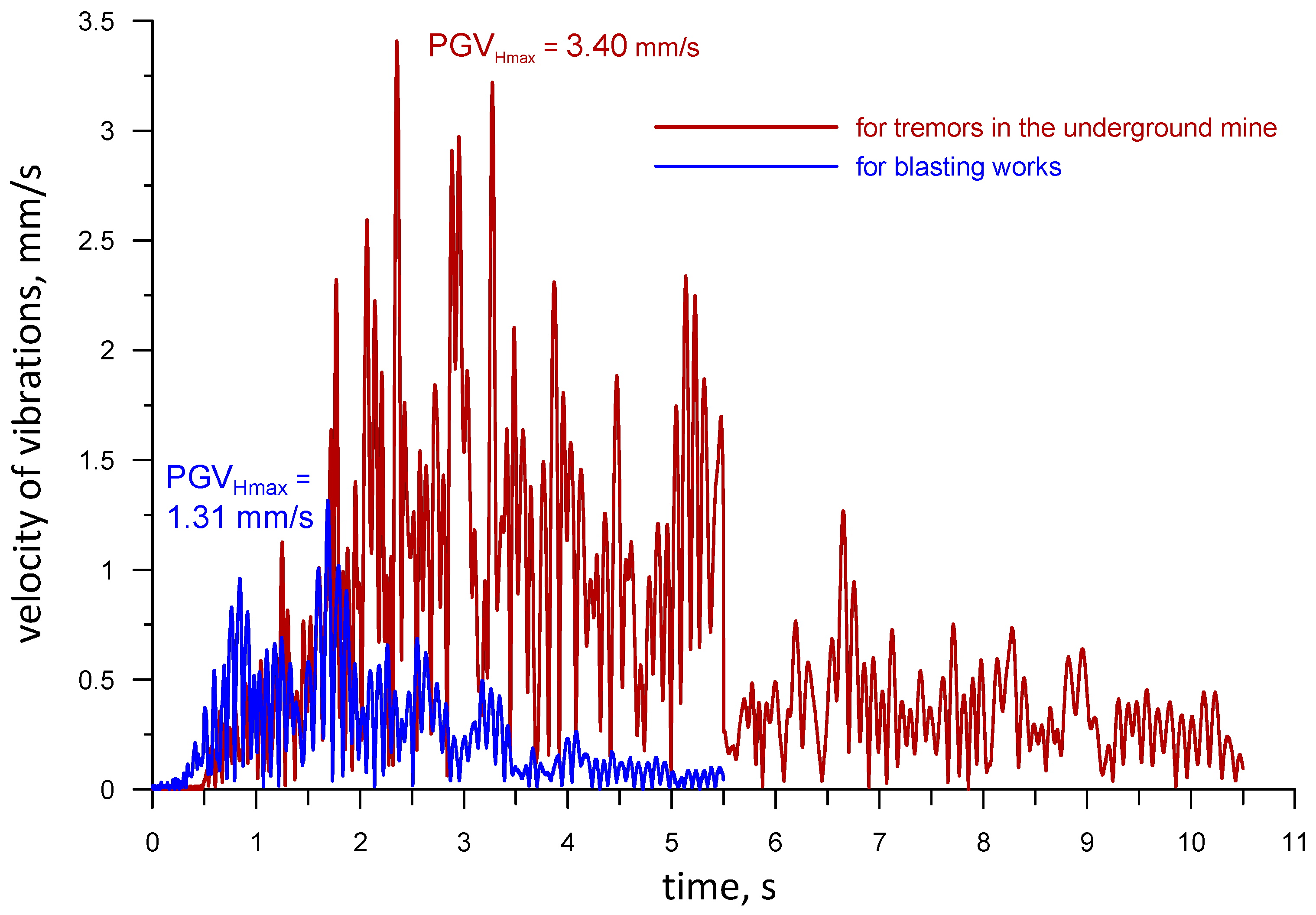

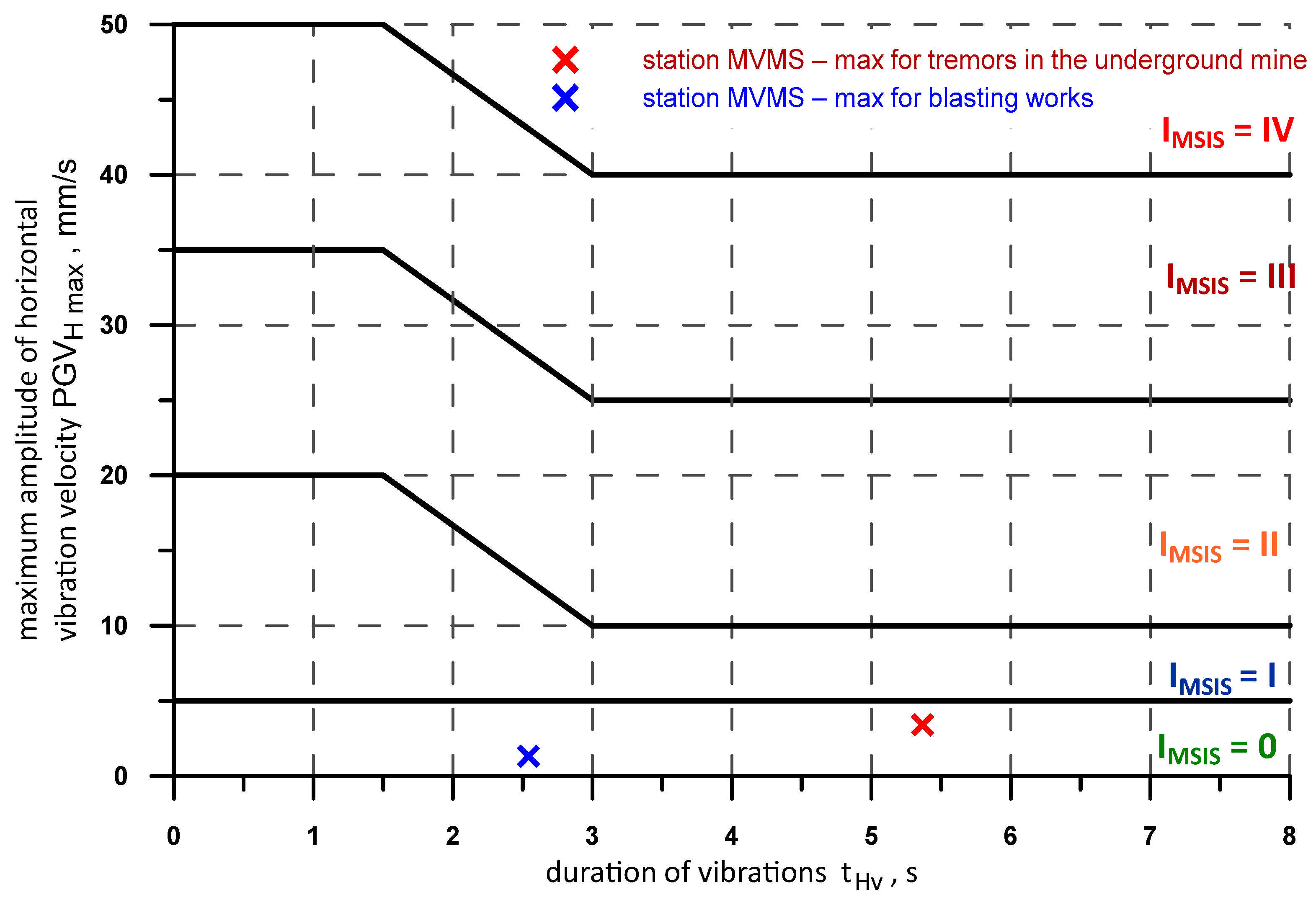
| Date | Time | PPV (mm/s) | Frequency (Hz) | Vector (mm/s) | ||||
|---|---|---|---|---|---|---|---|---|
| vz | vx | vy | fz | fx | fy | PVSxy | ||
| 02.08.2022 | 1:31 p.m. | 0.664 | 0.931 | 0.893 | 5.7 | 4.4 | 4.7 | 1.290 |
| 21.03.2023 | 1:40 p.m. | 0.870 | 1.312 | 0.954 | 5.7 | 5.7 | 6.0 | 1.622 |
| 05.04.2023 | 1:36 p.m. | 0.885 | 0.916 | 1.076 | 9.2 | 6.0 | 7.6 | 1.413 |
| 07.04.2023 | 1:35 p.m. | 0.755 | 0.992 | 0.862 | 6.7 | 4.9 | 6.1 | 1.314 |
| 04.05.2023 | 1:34 p.m. | 0.557 | 1.198 | 0.824 | 6.1 | 5.7 | 6.4 | 1.454 |
| Date | Time | Magnitude of the Event (J) | PPV (mm/s) | Frequency (Hz) | Vector (mm/s) | ||||
|---|---|---|---|---|---|---|---|---|---|
| vz | vx | vy | fz | fx | fy | PVSxy | |||
| 23.11.2022 | 4:52 p.m. | 8 × 107 | 1.976 | 1.816 | 2.602 | 8.3 | 9.4 | 7.7 | 3.173 |
| 15.12.2022 | 2:55 a.m. | 8 × 107 | 1.801 | 2.411 | 1.877 | 7.8 | 7.6 | 5.0 | 3.055 |
| 24.12.2022 | 4:52 a.m. | 1 × 108 | 1.923 | 2.892 | 2.655 | 6.6 | 6.5 | 4.9 | 3.926 |
| 27.01.2023 | 7:19 a.m. | 2 × 107 | 1.320 | 2.335 | 1.923 | 5.9 | 6.8 | 6.2 | 3.025 |
| 14.03.2023 | 6:44 a.m. | 4 × 106 | 1.312 | 1.953 | 2.068 | 6.6 | 5.2 | 6.3 | 2.844 |
| Central Frequency of Third-Octave Filter (Hz) | Value of the VPIB Indicator | ||
|---|---|---|---|
| Line A of the SWD-I Scale | Blasting Works in Open-Pit Mine | Mining Tremors in the Underground Mine | |
| 3.16 | 1.00 | 0.02 | 0.19 |
| 3.98 | 1.00 | 0.06 | 0.72 |
| 5.01 | 1.00 | 0.44 | 1.48 |
| 6.31 | 1.00 | 0.90 | 2.10 |
| 7.94 | 1.00 | 1.09 | 1.95 |
| 10.00 | 1.00 | 0.18 | 3.59 |
| 12.59 | 1.00 | 0.16 | 1.61 |
| 15.85 | 1.00 | 0.43 | 0.83 |
| 19.95 | 1.00 | 0.49 | 0.69 |
| 25.12 | 1.00 | 0.19 | 0.26 |
| 31.62 | 1.00 | 0.11 | 0.16 |
| Station No. | Vibration Source | Iv (mm2/s) | tHv (s) | PGVHmax (mm/s) |
|---|---|---|---|---|
| MVMS no. 1 | Blasting works | 0.32 | 2.54 | 1.31 |
| Underground mine tremors | 3.98 | 5.36 | 3.40 |
Disclaimer/Publisher’s Note: The statements, opinions and data contained in all publications are solely those of the individual author(s) and contributor(s) and not of MDPI and/or the editor(s). MDPI and/or the editor(s) disclaim responsibility for any injury to people or property resulting from any ideas, methods, instructions or products referred to in the content. |
© 2024 by the authors. Licensee MDPI, Basel, Switzerland. This article is an open access article distributed under the terms and conditions of the Creative Commons Attribution (CC BY) license (https://creativecommons.org/licenses/by/4.0/).
Share and Cite
Sołtys, A.; Pyra, J. The Influence of Vibrations Induced by Blasting Works in an Open-Pit Mine and Seismic Events in an Underground Mine on Building Structures—A Case Study. Appl. Sci. 2024, 14, 4414. https://doi.org/10.3390/app14114414
Sołtys A, Pyra J. The Influence of Vibrations Induced by Blasting Works in an Open-Pit Mine and Seismic Events in an Underground Mine on Building Structures—A Case Study. Applied Sciences. 2024; 14(11):4414. https://doi.org/10.3390/app14114414
Chicago/Turabian StyleSołtys, Anna, and Józef Pyra. 2024. "The Influence of Vibrations Induced by Blasting Works in an Open-Pit Mine and Seismic Events in an Underground Mine on Building Structures—A Case Study" Applied Sciences 14, no. 11: 4414. https://doi.org/10.3390/app14114414
APA StyleSołtys, A., & Pyra, J. (2024). The Influence of Vibrations Induced by Blasting Works in an Open-Pit Mine and Seismic Events in an Underground Mine on Building Structures—A Case Study. Applied Sciences, 14(11), 4414. https://doi.org/10.3390/app14114414






